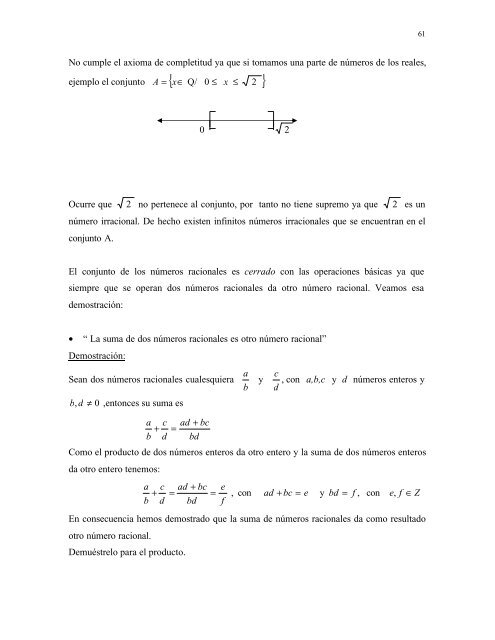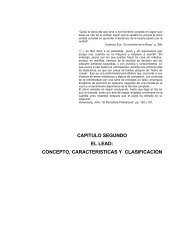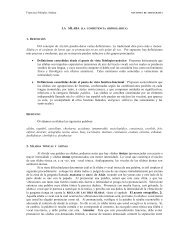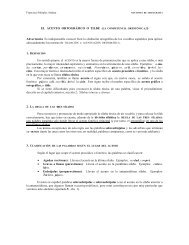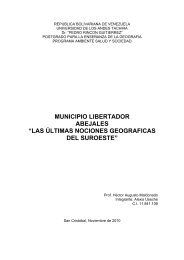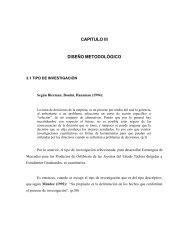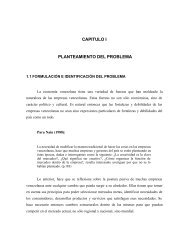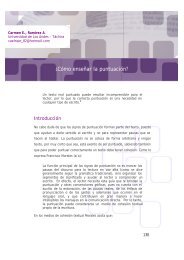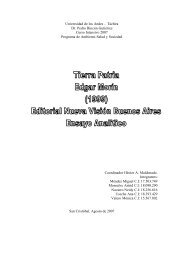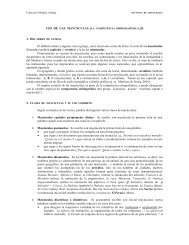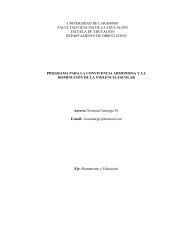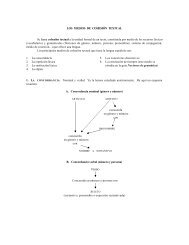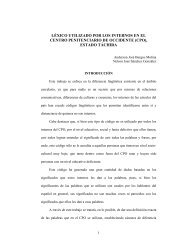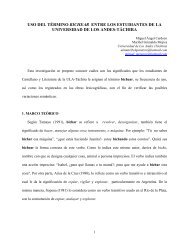No cumple el axioma de completitud ya que si tomamos una parte ...
No cumple el axioma de completitud ya que si tomamos una parte ...
No cumple el axioma de completitud ya que si tomamos una parte ...
You also want an ePaper? Increase the reach of your titles
YUMPU automatically turns print PDFs into web optimized ePapers that Google loves.
<strong>No</strong> <strong>cumple</strong> <strong>el</strong> <strong>axioma</strong> <strong>de</strong> <strong>completitud</strong> <strong>ya</strong> <strong>que</strong> <strong>si</strong> <strong>tomamos</strong> <strong>una</strong> <strong>parte</strong> <strong>de</strong> números <strong>de</strong> los reales,<br />
ejemplo <strong>el</strong> conjunto A = { x∈<br />
Q/ 0 ≤ x ≤ 2 }<br />
Ocurre <strong>que</strong><br />
2<br />
no pertenece al conjunto, por tanto no tiene supremo <strong>ya</strong> <strong>que</strong><br />
2<br />
61<br />
es un<br />
número irracional. De hecho existen infinitos números irracionales <strong>que</strong> se encuentran en <strong>el</strong><br />
conjunto A.<br />
El conjunto <strong>de</strong> los números racionales es cerrado con las operaciones bá<strong>si</strong>cas <strong>ya</strong> <strong>que</strong><br />
<strong>si</strong>empre <strong>que</strong> se operan dos números racionales da otro número racional. Veamos esa<br />
<strong>de</strong>mostración:<br />
• “ La suma <strong>de</strong> dos números racionales es otro número racional”<br />
Demostración:<br />
Sean dos números racionales cualesquiera<br />
b , d ≠ 0 ,entonces su suma es<br />
a c ad + bc<br />
+ =<br />
b d bd<br />
a<br />
b<br />
y<br />
c<br />
, con a,b,c y d números enteros y<br />
d<br />
Como <strong>el</strong> producto <strong>de</strong> dos números enteros da otro entero y la suma <strong>de</strong> dos números enteros<br />
da otro entero tenemos:<br />
a c ad + bc<br />
+ = =<br />
b d bd<br />
e<br />
f<br />
,<br />
con<br />
ad + bc = e<br />
y<br />
bd<br />
= f ,<br />
con<br />
e,<br />
f ∈ Z<br />
En consecuencia hemos <strong>de</strong>mostrado <strong>que</strong> la suma <strong>de</strong> números racionales da como resultado<br />
otro número racional.<br />
Demuéstr<strong>el</strong>o para <strong>el</strong> producto.<br />
0<br />
2
El conjunto <strong>de</strong> los números irracionales, <strong>cumple</strong> los <strong>axioma</strong>s:<br />
Para la adición:<br />
1. La conmutatividad,<br />
2. La asociatividad,<br />
Para <strong>el</strong> producto:<br />
3. La conmutatividad,<br />
4. La asociatividad.<br />
5. Distributividad,<br />
6. Axiomas <strong>de</strong> or<strong>de</strong>n 10, 11 y 12.<br />
<strong>No</strong> posee <strong>el</strong>emento neutro en la suma <strong>ya</strong> <strong>que</strong> <strong>el</strong> número cero no es irracional. Al igual <strong>que</strong><br />
los números racionales no <strong>cumple</strong>n <strong>el</strong> <strong>axioma</strong> <strong>de</strong> <strong>completitud</strong>.<br />
Un hecho <strong>de</strong> <strong>de</strong>stacar muy <strong>si</strong>gnificante es, no <strong>si</strong>empre la operación aritmética <strong>de</strong> dos<br />
números irracionales da como resultado otro irracional.<br />
Ejemplo:<br />
• El producto <strong>de</strong><br />
2<br />
×<br />
2<br />
=<br />
Pruéb<strong>el</strong>o para la suma.<br />
2<br />
por <strong>el</strong> mismo es:<br />
2 ( 2 ) = 2,<br />
pero 2∉I.<br />
Otra propiedad importante <strong>que</strong> <strong>cumple</strong> <strong>el</strong> conjunto <strong>de</strong> los números reales es la <strong>de</strong>n<strong>si</strong>dad, es<br />
<strong>de</strong>cir dados dos números reales <strong>si</strong>empre existe otro entre <strong>el</strong>los. Los números racionales y<br />
los irracionales también son <strong>de</strong>nsos mientras <strong>que</strong> los naturales y los enteros no lo son, <strong>ya</strong><br />
<strong>que</strong> <strong>si</strong> <strong>tomamos</strong> dos <strong>el</strong>ementos consecutivos nunca existirá otro <strong>el</strong>emento <strong>de</strong> ese conjunto<br />
entre <strong>el</strong>los, por lo tanto la <strong>de</strong>n<strong>si</strong>dad no la <strong>cumple</strong>n.<br />
62
LEYES DE LOS SIGNOS<br />
Existen <strong>una</strong> serie <strong>de</strong> leyes a respetar cuando se estén realizando las operaciones bá<strong>si</strong>cas<br />
con los números reales, <strong>el</strong>las son:<br />
Para la multiplicación:<br />
• ×+ = +<br />
+ , por ejemplo ( + 2 ) × ( + 3)<br />
= + 6<br />
• ×− = +<br />
− , por ejemplo ( − 2 ) × ( − 3)<br />
= + 6<br />
Signos iguales resultado po<strong>si</strong>tivo.<br />
• ×− = −<br />
+ , por ejemplo ( + 2) × ( − 3)<br />
= −6<br />
• ×+ = −<br />
− , por ejemplo ( − 2) × ( + 3)<br />
= −6<br />
Signos diferentes resultado negativo.<br />
Para la divi<strong>si</strong>ón:<br />
• ÷+ = +<br />
+ 4<br />
+ ; = + 2<br />
+ 2<br />
+ , por ejemplo ( 4 ) ÷ ( + 2)<br />
= + 2<br />
• ÷− = +<br />
− , por ejemplo ( 4 ) ÷ ( − 2)<br />
= + 2<br />
Signos iguales resultado po<strong>si</strong>tivo.<br />
• ÷− = −<br />
+ , por ejemplo ( 4) ÷ ( − 2)<br />
= −2<br />
• ÷+ = −<br />
− 4<br />
− ; = + 2<br />
− 2<br />
+ 4<br />
+ ; = −2<br />
− 2<br />
− , por ejemplo ( 4) ÷ ( + 2)<br />
= −2<br />
Signos diferentes resultado negativo.<br />
− 4<br />
− ; = −2<br />
+ 2<br />
Es bueno <strong>de</strong>stacar <strong>que</strong> se pue<strong>de</strong> representar un número negativo <strong>de</strong> tres maneras po<strong>si</strong>bles,<br />
<strong>el</strong>las son:<br />
63
1<br />
− 2<br />
Tercera forma.<br />
1<br />
− Primera forma<br />
2<br />
− 1<br />
Segunda forma y<br />
2<br />
Cada <strong>una</strong> <strong>de</strong> <strong>el</strong>las representa la misma cantidad, y por <strong>el</strong>lo es bueno tener presente este<br />
hecho a la hora <strong>de</strong> resolver los problemas <strong>que</strong> más ad<strong>el</strong>ante se presentarán.<br />
Estrategia para la Enseñanza <strong>de</strong> las Leyes <strong>de</strong> los Signos<br />
Las leyes <strong>de</strong> los <strong>si</strong>gnos fueron <strong>de</strong>finidas tácitamente por <strong>el</strong> francés Nicolás Chu<strong>que</strong>t en <strong>el</strong> <strong>si</strong>glo XV <strong>de</strong> nuestra<br />
era, se <strong>de</strong>finió así para <strong>que</strong> funcionen las operaciones con los números po<strong>si</strong>tivos y los negativos, es <strong>de</strong>cir se<br />
<strong>de</strong>be cumplir como verdad verda<strong>de</strong>ra los <strong>si</strong>guientes casos para así evitar po<strong>si</strong>bles contradicciones, <strong>el</strong>las son:<br />
Más por más es más,<br />
Menos por menos es más,<br />
Más por menos es menos y<br />
Menos por más es menos.<br />
Esto es muy abstracto para <strong>que</strong> los estudiantes en la primera y hasta en la segunda etapa <strong>de</strong><br />
la Educación Bá<strong>si</strong>ca le vean sentido y por en<strong>de</strong> sea <strong>si</strong>gnificativo, es por <strong>el</strong>lo <strong>que</strong> en estos<br />
casos las estrategias didácticas apropiadas son <strong>de</strong> gran utilidad para <strong>el</strong> logro <strong>de</strong> los<br />
aprendizajes dura<strong>de</strong>ros en los alumnos.<br />
Estrategia...<br />
64
E<br />
xiste <strong>una</strong> isla por las costas d<strong>el</strong> Atlántico llamada Pacifica, en <strong>el</strong>la existen ciudadanos<br />
buenos a los cuales se les asocia <strong>el</strong> <strong>si</strong>gno más “+” y ciudadanos malos a los cuales se<br />
les asocia <strong>el</strong> <strong>si</strong>gno menos “-“; los ciudadanos buenos eran aqu<strong>el</strong>las personas las<br />
cuales trabajaban, estudiaban, <strong>de</strong>portistas, artistas, niños y ancianos, mientras <strong>que</strong> los<br />
ciudadanos malos eran los ase<strong>si</strong>nos, ladrones, malandros, vagos y políticos. Se acordó en<br />
<strong>el</strong> consejo supremo <strong>de</strong> la isla <strong>que</strong> salir <strong>de</strong> la isla era equivalente al <strong>si</strong>gno menos “-“,<br />
mientras <strong>que</strong> entrar equivale al <strong>si</strong>gno más “+”.<br />
Los barcos <strong>que</strong> llegaban a la isla traían y se llevaban a personas, entonces <strong>el</strong> Rey<br />
interesado por saber lo beneficioso o perjudicial <strong>de</strong> este hecho hizo <strong>el</strong> <strong>si</strong>guiente análi<strong>si</strong>s:<br />
☺ Si un ciudadano bueno ”+” entra a Pacifica “+”, esto es po<strong>si</strong>tivo para la isla.<br />
Don<strong>de</strong> se obtiene <strong>que</strong> ( + )( + ) = + ,<br />
☺ Si un ciudadano malo “-“ sale <strong>de</strong> Pacifica “-“ , esto es po<strong>si</strong>tivo para la isla.<br />
Don<strong>de</strong> se obtiene <strong>que</strong> ( − )( − ) = + ,<br />
Si un ciudadano malo ”-” entra a Pacifica “+”, esto es negativo para la isla.<br />
Don<strong>de</strong> se obtiene <strong>que</strong> ( − )( + ) = − y<br />
Si un ciudadano bueno ”+” sale <strong>de</strong> Pacifica “-”, esto es negativo para la isla.<br />
Don<strong>de</strong> se obtiene <strong>que</strong> ( + )( − ) = − .<br />
Luego <strong>el</strong> Rey resumiendo este análi<strong>si</strong>s en <strong>una</strong> tabla obtuvo <strong>el</strong> <strong>si</strong>guiente resultado:<br />
Ciudadano bueno<br />
( + )<br />
Ciudadano malo<br />
( − )<br />
Entra a Pacifica<br />
( + )<br />
+<br />
_<br />
Sale <strong>de</strong> Pacifica<br />
( − )<br />
_<br />
+<br />
65
Entonces <strong>el</strong> Rey concluye <strong>que</strong> <strong>el</strong> producto <strong>de</strong> <strong>si</strong>gnos iguales es po<strong>si</strong>tivo, mientras <strong>que</strong> <strong>el</strong><br />
producto <strong>de</strong> <strong>si</strong>gnos diferentes es negativo y “colorín colorado esta estrategia ha<br />
terminado”.<br />
FRACCIONES<br />
x<br />
Una fracción es <strong>una</strong> expre<strong>si</strong>ón <strong>de</strong> la forma don<strong>de</strong> x e y pertenecen a los números<br />
y<br />
enteros, a<strong>de</strong>más “y” <strong>de</strong>be ser diferente <strong>de</strong> cero. ¿Por qué?.<br />
A la variable “x” se le conoce como numerador o divi<strong>de</strong>ndo y a la variable “y”<br />
<strong>de</strong>nominador o divisor.<br />
Variable algebraicamente se <strong>de</strong>fine a toda aqu<strong>el</strong>la letra <strong>que</strong> le po<strong>de</strong>mos a<strong>si</strong>gnar<br />
arbitrariamente cualquier valor numérico.<br />
ADICION Y SUSTRACCION DE FRACCIONES<br />
Cuando sume o reste fracciones se encontrará con dos casos po<strong>si</strong>bles, cada uno <strong>de</strong> <strong>el</strong>los<br />
tiene su forma particular <strong>de</strong> solución:<br />
Caso 1: Si los <strong>de</strong>nominadores <strong>de</strong> las fracciones son iguales, se escribe <strong>el</strong> mismo<br />
<strong>de</strong>nominador y se suman o restan los numeradores.<br />
a b c a ± b ± c<br />
sean a,<br />
b,<br />
c,<br />
e ∈ R, con e ≠ 0,<br />
entonces ± ± =<br />
e e e e<br />
Ejemplo:<br />
1 7 12 1 + 7 − 12 − 4<br />
+<br />
− = =<br />
5 5 5 5 5<br />
66
Caso 2: Si los <strong>de</strong>nominadores <strong>de</strong> las fracciones son diferentes, se proce<strong>de</strong> <strong>si</strong>guiendo la<br />
<strong>si</strong>guiente regla.<br />
sean a,<br />
b,<br />
c,<br />
d ∈ R,<br />
Ejemplo:<br />
2 3<br />
+ =<br />
5 6<br />
2<br />
con b,<br />
d ≠ 0,<br />
( 6)<br />
+ 5(<br />
3)<br />
12 + 15 27<br />
= =<br />
5(<br />
6)<br />
30 30<br />
entonces<br />
a c ad ± bc<br />
± =<br />
b d bd<br />
MULTIPLICACION DE FRACCIONES<br />
Para multiplicar fracciones se multiplica numerador con numerador y <strong>de</strong>nominador con<br />
<strong>de</strong>nominador es <strong>de</strong>cir, la multiplicación <strong>de</strong> fracciones es lineal.<br />
a c ac<br />
sean a,<br />
b,<br />
c,<br />
d ∈ R, con b,<br />
d ≠ 0,<br />
entonces ⋅ =<br />
b d bd<br />
Ejemplo:<br />
5 9<br />
× =<br />
2 4<br />
5<br />
2<br />
( 9)<br />
=<br />
( 4)<br />
8<br />
45<br />
DIVISION DE FRACCIONES<br />
Para dividir fracciones se multiplica en cruz, numerador <strong>de</strong> la primera fracción por<br />
<strong>de</strong>nominador <strong>de</strong> la segunda fracción y <strong>de</strong>nominador <strong>de</strong> la primera por numerador <strong>de</strong> la<br />
segunda es <strong>de</strong>cir, la divi<strong>si</strong>ón <strong>de</strong> fracciones es cruzada.<br />
a c ad<br />
sean a,<br />
b,<br />
c,<br />
d ∈ R, con b,<br />
c,<br />
d ≠ 0,<br />
entonces ÷ =<br />
b d bc<br />
Ejemplo:<br />
5 9 5<br />
÷ =<br />
3 7 3<br />
( 7)<br />
35<br />
=<br />
( 9)<br />
27<br />
Existe <strong>una</strong> forma <strong>de</strong> transformar las divi<strong>si</strong>ones en multiplicaciones, esta con<strong>si</strong>ste en invertir<br />
<strong>el</strong> or<strong>de</strong>n <strong>de</strong> la segunda fracción, es <strong>de</strong>cir <strong>el</strong> numerador pasa a ser <strong>de</strong>nominador y <strong>el</strong><br />
<strong>de</strong>nominador a ser numerador.<br />
67
a c a d ad<br />
sean a,<br />
b,<br />
c,<br />
d ∈ R, con b,<br />
c,<br />
d ≠ 0,<br />
entonces ÷ = ⋅ =<br />
b d b c bc<br />
Ejemplo:<br />
5 9 5 7 5<br />
÷ = × =<br />
3 7 3 9 3<br />
( 7)<br />
35<br />
=<br />
( 9)<br />
27<br />
Antes <strong>de</strong> comenzar con <strong>el</strong> trabajo operacional es bueno señalar <strong>que</strong> es indispensable <strong>el</strong><br />
dominio a<strong>de</strong>cuado <strong>de</strong> las tablas <strong>de</strong> multiplicar, existe la <strong>si</strong>guiente estrategia para <strong>el</strong><br />
dominio <strong>de</strong> dicho prerequi<strong>si</strong>to:<br />
1. Constru<strong>ya</strong> <strong>una</strong> tabla <strong>de</strong> 10x10 como la <strong>si</strong>guiente:<br />
*<br />
68
2. Coló<strong>que</strong>se en la primera fila y primera columna los números d<strong>el</strong> 1 al 9:<br />
* 1 2 3 4 5 6 7 8 9<br />
1<br />
2<br />
3<br />
4<br />
5<br />
6<br />
7<br />
8<br />
9<br />
3. Ahora, en la segunda fila colo<strong>que</strong>n los números <strong>de</strong> 1 en 1; en la segunda fila <strong>de</strong> 2 en<br />
dos; en la fila 3 <strong>de</strong> tres en tres y así suce<strong>si</strong>vamente con <strong>el</strong> resto <strong>de</strong> filas.<br />
* 1 2 3 4 5 6 7 8 9<br />
1 1 2 3 4 5 6 7 8 9<br />
2 2 4 6 8 10 12 14 16 18<br />
3 3 6 9 12 15 18 21 24 27<br />
4<br />
5 5 10 15 20 25 30 35 40 45<br />
6<br />
7 7 14 21 28 35 42 49 56 63<br />
8<br />
9 9 18 27 36 45 54 63 72 81<br />
4. Ya tenemos construida las tablas <strong>de</strong> multiplicar. Para conseguir <strong>el</strong> resultado <strong>de</strong> <strong>una</strong><br />
multiplicación <strong>de</strong>terminada proce<strong>de</strong>mos <strong>de</strong> la <strong>si</strong>guiente manera:<br />
¿Cuánto es 9x7?. Ubicamos primero la fila 9, luego la columna 7, <strong>el</strong> <strong>si</strong>tio don<strong>de</strong> se intercepte esta fila con la<br />
columna es <strong>el</strong> resultado <strong>de</strong>seado.<br />
69
2)<br />
* 1 2 3 4 5 6 7 8 9<br />
1 1 2 3 4 5 6 7 8 9<br />
2 2 4 6 8 10 12 14 16 18<br />
3 3 6 9 12 15 18 21 24 27<br />
4 4 8 12 16 20 24 28 32 36<br />
5 5 10 15 20 25 30 35 40 45<br />
6 6 12 18 24 30 36 42 48 54<br />
7 7 14 21 28 35 42 49 56 63<br />
8 8 16 24 32 40 48 56 64 72<br />
9 9 18 27 36 45 54 63 72 81<br />
La ca<strong>si</strong>lla <strong>de</strong> intersección nos indica 63, por lo tanto su resultado es 63. Este proceso se<br />
aplica <strong>de</strong> manera análoga para resolver cualquier multiplicación <strong>que</strong> nece<strong>si</strong>temos.<br />
Ejercicios resu<strong>el</strong>tos:<br />
Efectúe lo <strong>si</strong>guiente:<br />
1)<br />
1 5 1×<br />
7 + 2 × 5 7 + 10 17<br />
+ =<br />
= =<br />
2 7 2 × 7 14 14<br />
Como es <strong>una</strong> suma <strong>de</strong> fracciones <strong>de</strong> diferentes <strong>de</strong>nominadores, se aplicó la regla<br />
respectiva.<br />
Columna 7<br />
⎡3 2 ⎤ ⎡ 6 ⎤ ⎡3<br />
× 4 − 5 × 2 ⎤ ⎡6<br />
× 1 + 5 × 7 ⎤ ⎡12 −10<br />
⎤ ⎡ 6 + 35⎤<br />
⎢ − 7<br />
= × =<br />
5 4 ⎥ × ⎢ +<br />
5 ⎥ = ⎢<br />
×<br />
5 4 ⎥ ⎢ 5 1 ⎥ ⎢ 20 ⎥ ⎢ 5 ⎥<br />
⎣ ⎦ ⎣ ⎦ ⎣ × ⎦ ⎣ × ⎦ ⎣ ⎦ ⎣ ⎦<br />
⎡ 2 ⎤ ⎡41⎤<br />
2 × 41 82<br />
= ⎢ = =<br />
20<br />
⎥ × ⎢<br />
5<br />
⎥<br />
⎣ ⎦ ⎣ ⎦ 20 × 5 100<br />
Fila 9<br />
70
3)<br />
⎡ 1 5⎤<br />
⎡ 3⎤<br />
⎡1×<br />
4⎤<br />
⎡4<br />
× 3⎤<br />
⎢ ÷ + 4<br />
=<br />
2 4 ⎢ × = +<br />
⎣<br />
⎥<br />
⎦ ⎣ 8⎥<br />
⎦<br />
⎢<br />
⎣2<br />
× 5⎥<br />
⎦<br />
⎢<br />
⎣ 8×<br />
1⎥<br />
⎦<br />
32 + 120<br />
= =<br />
80<br />
4<br />
10<br />
152<br />
80<br />
12 4×<br />
8 + 10×<br />
12<br />
+ =<br />
=<br />
8 10×<br />
8<br />
En <strong>el</strong> mundo matemático <strong>de</strong>bemos ca<strong>si</strong> <strong>si</strong>empre pensar en lo <strong>si</strong>guiente. “ Será <strong>que</strong> esto lo<br />
puedo hacer <strong>de</strong> manera más sencilla”. Observemos <strong>que</strong> <strong>una</strong> fracción generalmente se pue<strong>de</strong><br />
copiar como otra equivalente pero más pe<strong>que</strong>ña. Esto se pue<strong>de</strong> realizar gracias al teorema<br />
<strong>de</strong> la <strong>si</strong>mplificación.<br />
CRITERIO DE SIMPLIFICACION<br />
abc ab<br />
Sean a , b,<br />
c,<br />
d,<br />
e ∈R , entonces = , con c,<br />
d,<br />
e ≠<br />
c<strong>de</strong> <strong>de</strong><br />
Observe <strong>que</strong> en esencia lo <strong>que</strong> se hizo fue <strong>el</strong>iminar la variable “ c ”, esto se pue<strong>de</strong> hacer<br />
<strong>si</strong>empre y cuando todos los <strong>el</strong>ementos d<strong>el</strong> numerador estén multiplicando entre <strong>si</strong> y todos<br />
los <strong>el</strong>ementos d<strong>el</strong> <strong>de</strong>nominador también lo hagan y a<strong>de</strong>más exista un <strong>el</strong>emento <strong>que</strong> esté<br />
arriba y abajo a la vez.<br />
Aquí se presenta un error muy común a la hora <strong>de</strong> aplicar este criterio maravilloso,<br />
a + bc<br />
≠<br />
a<strong>de</strong><br />
bc<br />
.<br />
<strong>de</strong><br />
Aquí no se pue<strong>de</strong> <strong>el</strong>iminar la variable “ a ” <strong>ya</strong> <strong>que</strong> <strong>el</strong>la en <strong>el</strong> numerador está<br />
sumando, por lo tanto no <strong>cumple</strong> las condiciones d<strong>el</strong> Criterio <strong>de</strong> Simplificación, luego no<br />
se pue<strong>de</strong> <strong>el</strong>iminar.<br />
4)<br />
⎡12<br />
1⎤<br />
⎡25<br />
10 ⎤ ⎡13⎤<br />
⎡15<br />
⎤ 13 × 15<br />
⎢ +<br />
= =<br />
5 5⎥<br />
× ⎢ −<br />
×<br />
26 26⎥<br />
= ⎢ 5 ⎥ ⎢26⎥<br />
⎣ ⎦ ⎣ ⎦ ⎣ ⎦ ⎣ ⎦ 5 × 26<br />
0.<br />
71
Obsérvese <strong>que</strong> <strong>el</strong> 15 y <strong>el</strong> 26 se pue<strong>de</strong>n <strong>de</strong>scomponer en producto <strong>de</strong> otros números<br />
llamados números primos ♣ o factores primos <strong>de</strong> un número dado, luego aplicamos <strong>el</strong><br />
criterio <strong>de</strong> <strong>si</strong>mplificación <strong>si</strong> es po<strong>si</strong>ble.<br />
13×<br />
5 × 3<br />
=<br />
5 × 13 × 2<br />
3<br />
2<br />
1 7 23 22 7<br />
5) + − + 2 − + =<br />
3 4 12 6 18<br />
Con lo <strong>que</strong> conocemos hasta ahora <strong>de</strong>bemos agrupar en pares y luego ir resolviendo así,<br />
•<br />
•<br />
•<br />
1 7 4 + 21 25<br />
+ = =<br />
3 4 12 12<br />
23 − 23 + 24 1<br />
− + 2 = =<br />
12 12 12<br />
22 7 11 7<br />
− + = − + =<br />
6 18 3 18<br />
Así tenemos <strong>que</strong>,<br />
1 7 23 22 7<br />
+ − + 2 − +<br />
3 4 12 6 18<br />
Resolviendo <strong>el</strong> lado <strong>de</strong>recho,<br />
=<br />
( − 11)<br />
18 + 21 −198<br />
+ 21 − 177 59<br />
= = = −<br />
3×<br />
18 54 54 18<br />
25 1 59<br />
+ −<br />
12 12 18<br />
25 1 59 26 59 13 59 13 × 18 − 6 × 59 234 - 354 − 120<br />
+ − = − = − =<br />
= = =<br />
12 12 18 12 18 6 18 6 × 18 108 108<br />
Simplificando,<br />
120 60 30 10<br />
− = − = − = −<br />
108 54 27 9<br />
Así tenemos,<br />
1 7 23 22 7 10<br />
+ − + 2 − + = -<br />
3 4 12 6 18 9<br />
♣ Un número se llama primo <strong>si</strong> solamente es divi<strong>si</strong>ble por <strong>el</strong> mismo y por la unidad.<br />
72
Existen algunos criterios <strong>que</strong> nos permiten saber <strong>si</strong> un número entero<br />
es divi<strong>si</strong>ble entre, dos, tres y cinco.<br />
Un número es divi<strong>si</strong>ble entre dos, <strong>si</strong> termina en cero o es par.<br />
Un número es divi<strong>si</strong>ble entre tres, <strong>si</strong> la suma <strong>de</strong> sus dígitos es un<br />
número divi<strong>si</strong>ble entre tres. Por ejemplo:<br />
1263 es divi<strong>si</strong>ble entre tres <strong>ya</strong> <strong>que</strong> 1+2+6+3=12 y 12 es divi<strong>si</strong>ble entre<br />
tres.<br />
1263<br />
=<br />
3<br />
421<br />
Un número es divi<strong>si</strong>ble entre cinco, <strong>si</strong> termina en cero o cinco.<br />
OTROS CRITERIOS DE DIVISIBILIDAD:<br />
Un número es divi<strong>si</strong>ble entre cuatro, <strong>si</strong> <strong>el</strong> número formado con las<br />
dos últimas cifras es múltiplo <strong>de</strong> cuatro. Por ejemplo:<br />
936 es divi<strong>si</strong>ble entre 4, <strong>ya</strong> <strong>que</strong> 36 es múltiplo <strong>de</strong> 4 ( 9 × 4 = 36)<br />
Un número es divi<strong>si</strong>ble entre seis, <strong>si</strong> <strong>el</strong> número es divi<strong>si</strong>ble por dos<br />
y tres <strong>de</strong> manera <strong>si</strong>multánea.<br />
Un número es divi<strong>si</strong>ble entre nueve, <strong>si</strong> la suma <strong>de</strong> sus cifras es<br />
múltiplo <strong>de</strong> nueve. Por ejemplo:<br />
26991 es divi<strong>si</strong>ble entre 9, <strong>ya</strong> <strong>que</strong> 2+6+9+9+1=27 y 27 es múltiplo <strong>de</strong> 9.<br />
Un número es divi<strong>si</strong>ble entre diez, <strong>si</strong> termina en cero.<br />
73
Observe <strong>que</strong> <strong>el</strong> problema anterior fue un poco largo, <strong>ya</strong> <strong>que</strong> solamente podíamos trabajar<br />
con pares <strong>de</strong> fracciones, pero no hay <strong>que</strong> preocuparse por <strong>el</strong>lo, por<strong>que</strong> existe un<br />
procedimiento más sencillo <strong>que</strong> nos permitirá transformar las fracciones <strong>que</strong> aparezcan<br />
sumando o restando en <strong>una</strong> sola. Para <strong>el</strong>lo utilizará <strong>el</strong> mínimo común múltiplo<br />
( m . c.<br />
m.<br />
)<br />
Se <strong>de</strong>nomina m.c.m. <strong>de</strong> dos números a y b al menor número no nulo <strong>que</strong> es múltiplo <strong>de</strong> a<br />
y <strong>si</strong>multáneamente <strong>de</strong> b.<br />
♦ Un número es divi<strong>si</strong>ble entre otro cuando su cociente es un entero o cuando <strong>el</strong> numerador <strong>de</strong> <strong>una</strong> fracción<br />
es un múltiplo d<strong>el</strong> <strong>de</strong>nominador <strong>de</strong> dicha fracción.<br />
Procedimiento para hallar <strong>el</strong> m . c.<br />
m.<br />
El m. c.<br />
m.<br />
<strong>de</strong> un conjunto <strong>de</strong> números, es otro número conformado por los factores primos<br />
comunes y no comunes con su mayor exponente <strong>de</strong> ese conjunto <strong>de</strong> números.<br />
Ejemplo:<br />
↔ Halle <strong>el</strong> mínimo común múltiplo <strong>de</strong> 25, 50, 45.<br />
Solución:<br />
Primero <strong>de</strong>scomponemos cada uno <strong>de</strong> esos números en sus factores primos<br />
• 25 = 5×<br />
5<br />
Luego, aplicando la <strong>de</strong>finición<br />
•<br />
50 = 2 × 5×<br />
5<br />
m . c.<br />
m.<br />
(25 , 50 , 45 ) = 5 × 5×<br />
2×<br />
3×<br />
3 = 450<br />
•<br />
45 = 3×<br />
3×<br />
5<br />
Este m . c.<br />
m.<br />
tiene <strong>una</strong> propiedad fundamental, <strong>de</strong> ser <strong>el</strong> menor número divi<strong>si</strong>ble ♦ entre cada<br />
uno <strong>de</strong> los números en cuestión. Veamos <strong>si</strong> 450 <strong>cumple</strong> esta propiedad.<br />
450<br />
•<br />
= 18<br />
25<br />
•<br />
450<br />
= 9<br />
50<br />
•<br />
450<br />
= 10<br />
45<br />
74
7 11 108 34 1<br />
6. Resu<strong>el</strong>va − + + − =<br />
9 36 18 3 6<br />
Solución:<br />
El m . c.<br />
m.<br />
también se conoce como <strong>el</strong> mínimo común <strong>de</strong>nominador <strong>ya</strong> <strong>que</strong> hallaremos <strong>el</strong><br />
m . c.<br />
m.<br />
entre <strong>el</strong> conjunto <strong>de</strong> <strong>de</strong>nominadores.<br />
• 9 = 3×<br />
3<br />
•36<br />
= 2×<br />
2×<br />
3×<br />
3<br />
•18<br />
= 2×<br />
3×<br />
3<br />
Así , <strong>el</strong> m . c.<br />
m.<br />
(9, 36 ,18 , 3, 6 )= 2 × 2 × 3×<br />
3 = 36<br />
• 3 = 3<br />
• 6 = 2 × 3<br />
Ahora este m . c.<br />
m.<br />
lo dividiremos entre cada uno <strong>de</strong> los <strong>de</strong>nominadores y su resultado lo<br />
multiplicaremos por su respectivo numerador.<br />
7 11 108 34 1<br />
− + + − =<br />
9 36 18 3 6<br />
28 −11<br />
+ 216 + 408 − 6 652 − 17 635<br />
=<br />
= =<br />
36<br />
36 36<br />
4<br />
( 7 ) −1(<br />
11 ) + 2 ( 108 ) + 12 ( 34 ) − 6 ( 1 )<br />
Otro procedimiento llamado <strong>el</strong> <strong>de</strong> las columnas para hallar <strong>el</strong> m . c.<br />
m.<br />
Dispónganse la serie <strong>de</strong> números en distintas columnas y proceda a hallarles sus factores <strong>de</strong> manera<br />
<strong>si</strong>multánea como la <strong>si</strong>guiente representación:<br />
25 50 45 5<br />
5 10 9 2<br />
1 5 3 3<br />
1 3 3<br />
1 5<br />
36<br />
Factores primos<br />
El producto <strong>de</strong> la columna <strong>de</strong> los factores primos es <strong>el</strong> m . c.<br />
m.<br />
, entonces<br />
5 2×<br />
3×<br />
3×<br />
5 = 450.<br />
× Don<strong>de</strong> m<br />
. c.<br />
m.<br />
( 25, 50, 45 ) = 450<br />
=<br />
75
Otro procedimiento basado en la <strong>de</strong>finición d<strong>el</strong> m . c.<br />
m.<br />
Halle los múltiplos <strong>de</strong> cada uno <strong>de</strong> los números problema, luego revís<strong>el</strong>os y s<strong>el</strong>eccione <strong>el</strong><br />
menor común a esa serie <strong>de</strong> números problemas. Ejemplo:<br />
Los múltiplos <strong>de</strong> los números 25, 50 y 45 son:<br />
M( 25 ) = { 25,50,75,100,125,150<br />
,175,200, 225, 250,275,30 0,325,350, 375,400,425,450,<br />
... }<br />
M( 50 ) = { 50, 1 00, 150,<br />
200, 250 ,30 0, 350, 400, 450, 500, 550, 600 ... }<br />
M( 45 ) = { 45, 90, 135 , 180, 225,<br />
270, 315, 360, 405, 450, 495, 540, 585 ... }<br />
Observe <strong>que</strong> <strong>el</strong> múltiplo más pe<strong>que</strong>ño y común a los tres números es 450 por en<strong>de</strong> <strong>el</strong><br />
m . c.<br />
m.<br />
<strong>de</strong> esa serie <strong>de</strong> números es 450.<br />
Si se pregunta ¿cuál <strong>de</strong> esos procedimientos utilizar?, pues no se preocupe , <strong>ya</strong> <strong>que</strong> usted<br />
pue<strong>de</strong> utilizar <strong>el</strong> procedimiento <strong>que</strong> más domine, por<strong>que</strong> no importa la vía <strong>que</strong> tome, <strong>el</strong><br />
resultado <strong>de</strong>be ser <strong>el</strong> mismo.<br />
El máximo común divisor (M.C.D.) <strong>de</strong> dos o más números es <strong>el</strong> máximo número<br />
<strong>que</strong> divi<strong>de</strong> a todos los <strong>de</strong>más.<br />
Se <strong>de</strong>nomina M.C.D. <strong>de</strong> dos números a y b al mayor número no nulo <strong>que</strong> es divisor <strong>de</strong> a<br />
y <strong>si</strong>multáneamente <strong>de</strong> b.<br />
76
Procedimiento para hallar <strong>el</strong> M.C.D.<br />
El M.C.D. <strong>de</strong> un conjunto <strong>de</strong> números, es otro número conformado por los factores primos<br />
comunes con su menor exponente <strong>de</strong> ese conjunto <strong>de</strong> números.<br />
Ejemplo:<br />
↔ Halle <strong>el</strong> máximo común divisor <strong>de</strong> 25, 50, 45.<br />
Solución:<br />
Primero <strong>de</strong>scomponemos cada uno <strong>de</strong> esos números en sus factores primos<br />
• 25 = 5×<br />
5<br />
Luego, aplicando la <strong>de</strong>finición<br />
M.C.D. (25 , 50 , 45 ) = 5<br />
•<br />
50 = 2 × 5×<br />
5<br />
•<br />
45 = 3×<br />
3×<br />
5<br />
Este M.C.D. tiene <strong>una</strong> propiedad fundamental, <strong>de</strong> ser <strong>el</strong> mayor número divisor entre<br />
cada uno <strong>de</strong> los números en cuestión. Veamos <strong>si</strong> 5 <strong>cumple</strong> esta propiedad.<br />
•<br />
25<br />
= 5<br />
5<br />
Ejercicio resu<strong>el</strong>to:<br />
•<br />
50<br />
= 10<br />
5<br />
↔ Halle <strong>el</strong> M . C.<br />
D.<br />
entre 25, 125 y 100.<br />
Solución:<br />
•<br />
45<br />
= 9<br />
5<br />
Descomponemos los números en sus factores primos, así<br />
25 = 5×<br />
5<br />
125 = 5×<br />
5×<br />
5<br />
100 = 2 × 2 × 5×<br />
5<br />
Observe <strong>que</strong> 5 es un factor común en la serie <strong>de</strong> números, pero observe también <strong>que</strong> <strong>el</strong><br />
máximo es 5×<br />
5,<br />
<strong>ya</strong> <strong>que</strong> está en cada uno <strong>de</strong> los números estudiados , así <strong>que</strong> <strong>el</strong><br />
M. C.<br />
D.<br />
es 25.<br />
Se <strong>de</strong>nota como M . C.<br />
D.<br />
( 25,<br />
125,<br />
100 ) =<br />
25<br />
77
↔ Halle <strong>el</strong> M. C.<br />
D.<br />
entre 135, 45 y 630.<br />
Solución:<br />
Descomponemos los números en sus factores primos, así<br />
3<br />
135 = 3×<br />
3×<br />
3×<br />
5 = 3 × 5<br />
2<br />
45 = 3×<br />
3×<br />
5 = 3 × 5<br />
630 = 2×<br />
3×<br />
3×<br />
5×<br />
7 = 2×<br />
3<br />
2<br />
× 5×<br />
7<br />
Nótese <strong>que</strong> <strong>el</strong> factor común es <strong>el</strong> 3 y <strong>el</strong> 5, ¿por qué <strong>el</strong> 2 y <strong>el</strong> 7 no lo son?, luego se toma<br />
2<br />
<strong>el</strong> <strong>que</strong> tenga menor exponente, así <strong>el</strong> M . C.<br />
D.<br />
( 135,<br />
45,<br />
630 ) = 3 × 5 = 45 .<br />
Otro procedimiento basado en la <strong>de</strong>finición d<strong>el</strong> M . C.<br />
D.<br />
Halle los divisores <strong>de</strong> cada uno <strong>de</strong> los números problema, luego revís<strong>el</strong>os y s<strong>el</strong>eccione <strong>el</strong><br />
mayor común a esa serie <strong>de</strong> números problemas. Ejemplo:<br />
Los divisores <strong>de</strong> los números 250, 500 y 450 son:<br />
D ( 250 ) = { 250, 125, 50, 25, 10 , 5 }<br />
D ( 500 ) = { 500, 250, 125,<br />
50, 25, 10, 5}<br />
D ( 450 ) = { 450,<br />
225, 150, 90, 75 , 50, 45, 30, 25, 18, 15, 10, 5, 3}<br />
Observe <strong>que</strong> <strong>el</strong> divisor común y mayor a los tres números es 50 por en<strong>de</strong> <strong>el</strong> M . C.<br />
D.<br />
<strong>de</strong><br />
esa serie <strong>de</strong> números es . C.<br />
D.<br />
( 250,<br />
500, 450 ) = 50<br />
M .<br />
Este concepto será <strong>de</strong> gran utilidad en <strong>el</strong> capítulo 2 referido a las técnicas <strong>de</strong> factorización.<br />
78
EJERCICIOS 1.2<br />
Resu<strong>el</strong>va y <strong>si</strong>mplifi<strong>que</strong> las <strong>si</strong>guientes operaciones:<br />
1. − 65 − 43 + 5 + 1343 − ( − 45)<br />
=<br />
2. − ( 34 − 6 ) + 46 − 68 =<br />
3. 5 + [ 22 ( 33−<br />
13)<br />
−16<br />
] =<br />
4. [ 3 ( 32 + 5 ) − 78 − ( −34<br />
−12)<br />
] 2 =<br />
3 18<br />
5. + =<br />
7 7<br />
−12<br />
6 2<br />
6. + − =<br />
8 8 8<br />
7.<br />
3<br />
−<br />
7<br />
( − 45)<br />
=<br />
− 7<br />
3 11 5<br />
8. + − =<br />
4 2 8<br />
33 8 ⎛ 5 ⎞<br />
9. − + − ⎜ ⎟ − 7 =<br />
11 4 ⎝ − 3 ⎠<br />
− 45 ⎡12<br />
14 ⎤ 1<br />
10. + ⎢ × ⎥ − =<br />
− 5 ⎣ 7 7 ⎦ 5<br />
11.<br />
( 3)<br />
⎡9 −<br />
⎢ ÷<br />
⎣7<br />
14<br />
⎤ 3<br />
⎥ ×<br />
⎦ 4<br />
1 ⎧2<br />
⎡−<br />
7 13 ⎛ 1 ⎞ ⎤ ⎫<br />
12. ⎨ − 7 ⎢ − − 2 ⎜33<br />
− ⎟ ⎥ ⎬ =<br />
2 ⎩5<br />
⎣ 11 3 ⎝ 4 ⎠ ⎦ ⎭<br />
13. ( ) = 2 × 2 × 2 × 2 × 2 =<br />
2 5<br />
⎛ 3 ⎞ 3 3<br />
14. ⎜ ⎟ = × =<br />
⎝ 7 ⎠ 7 7<br />
2<br />
=<br />
⎡ 2<br />
⎛ 1 ⎞<br />
⎤<br />
⎢⎜<br />
⎟ ⎥<br />
15.<br />
⎢⎝<br />
2 ⎠ ⎛ 2⎞<br />
3 +<br />
⎥<br />
⎢<br />
⎜ ⎟<br />
⎥<br />
=<br />
3<br />
⎝ ⎠<br />
⎢ ⎛ 3⎞<br />
5<br />
⎜ ⎟ ⎥<br />
⎢⎣<br />
⎝5<br />
⎠ ⎥⎦<br />
16. ␇<br />
4 3<br />
−<br />
9 8<br />
7 11<br />
−<br />
12 18<br />
=<br />
1<br />
−3<br />
17.<br />
3<br />
=<br />
−12<br />
5<br />
+<br />
8 16<br />
3 1<br />
−<br />
18.<br />
4 2<br />
=<br />
2<br />
1−<br />
3<br />
5 3<br />
+<br />
19.<br />
21 7<br />
=<br />
5 35<br />
−<br />
12 24<br />
3 2<br />
−<br />
20.<br />
4 3<br />
=<br />
19 5<br />
−<br />
18 6<br />
1<br />
21. 1 − =<br />
1<br />
2 −<br />
1<br />
3 −<br />
2<br />
79<br />
␇ Estas fracciones se llaman fracciones complejas.
1<br />
22. − 4 +<br />
=<br />
1<br />
− 3+<br />
1<br />
− 2 +<br />
3<br />
1<br />
23. 1 + =<br />
1<br />
1+<br />
1<br />
1+<br />
2<br />
LOS NUMEROS DECIMALES<br />
Un número <strong>de</strong>cimal es aqu<strong>el</strong> número <strong>que</strong> posee <strong>una</strong> <strong>parte</strong> entera y <strong>una</strong> <strong>de</strong>cimal. Se<br />
i<strong>de</strong>ntifica rápidamente por<strong>que</strong> posee <strong>una</strong> coma entre alguno <strong>de</strong> sus dígitos. Ejemplo:<br />
• 23,546<br />
• 1,6588<br />
• 0,78326428<br />
• -3,000<br />
La <strong>parte</strong> entera es aqu<strong>el</strong>la <strong>que</strong> se encuentra antes <strong>de</strong> la coma y la <strong>parte</strong> <strong>de</strong>cimal la <strong>que</strong> se<br />
encuentra <strong>de</strong>spués <strong>de</strong> <strong>el</strong>la. En un número <strong>de</strong>cimal cada <strong>una</strong> <strong>de</strong> las po<strong>si</strong>ciones <strong>de</strong> los dígitos<br />
tiene un nombre específico y <strong>de</strong>pendiendo <strong>de</strong> <strong>el</strong>lo se pronuncia la cantidad <strong>de</strong> <strong>una</strong> manera<br />
<strong>de</strong>terminada.<br />
En <strong>el</strong> <strong>si</strong>guiente número <strong>de</strong>cimal, veamos <strong>el</strong> nombre <strong>de</strong> alg<strong>una</strong>s <strong>de</strong> las po<strong>si</strong>ciones <strong>de</strong> los<br />
dígitos.<br />
Millardos<br />
Centena <strong>de</strong> millón<br />
Decena <strong>de</strong> millón<br />
Unidad <strong>de</strong> millón<br />
Centena <strong>de</strong> mil<br />
Decena <strong>de</strong> mil<br />
Unidad <strong>de</strong> mil<br />
Centena<br />
<strong>de</strong>cena<br />
Unidad<br />
Décimas<br />
Centé<strong>si</strong>mas<br />
Milé<strong>si</strong>mas<br />
Diezmilé<strong>si</strong>ma<br />
Cienmilé<strong>si</strong>mas<br />
43
3 8 7 9 5 9 7 0 7 5 , 8 4 1 3 2<br />
Este número se lee como “ Tres millardos, ochocientos setenta y nueve millones,<br />
quinientos noventa y <strong>si</strong>ete mil setenta y cinco unida<strong>de</strong>s con ochenta y cuatro<br />
mil ciento treinta y dos cienmilé<strong>si</strong>mas “<br />
Ejercicios:<br />
Escriba los <strong>si</strong>guientes números en forma verbal:<br />
↔ 434,7575<br />
↔ 0,4553<br />
↔ 1200000000<br />
↔ 540000004<br />
Escriba los <strong>si</strong>guientes números en forma numérica:<br />
↔ Ochocientos millones cuatro unida<strong>de</strong>s con noventa milé<strong>si</strong>mas.<br />
↔ 45346,0024<br />
↔ 4,657<br />
↔ Cuarenta y cinco mil novecientos sesenta y tres con ocho milé<strong>si</strong>mas venti<strong>una</strong> cien<br />
milloné<strong>si</strong>ma.<br />
↔ Una cienmilé<strong>si</strong>mas.<br />
↔ Cuatro mil <strong>una</strong> unidad con treinta y tres milé<strong>si</strong>mas.<br />
↔ Treinta y seis mil millardos con tres unida<strong>de</strong>s.<br />
↔ Ciento treinta y ocho millones cuatro unida<strong>de</strong>s con tres décimas.<br />
Con los números <strong>de</strong>cimales también po<strong>de</strong>mos realizar las operaciones bá<strong>si</strong>cas, para efectuar<br />
la adición o sustracción <strong>de</strong>bemos tener presente <strong>que</strong> coincida las po<strong>si</strong>ciones <strong>de</strong> la <strong>parte</strong><br />
entera así como la <strong>de</strong>cimal. Ejemplo:<br />
↔ ¿Cuál es <strong>el</strong> valor <strong>de</strong> 23 , 456 − 6,<br />
6456 − 0,<br />
46 + 342,<br />
7 = ?<br />
Solución:<br />
21
Sume por separado las cantida<strong>de</strong>s po<strong>si</strong>tivas y las negativas disponiendo <strong>una</strong> <strong>de</strong>bajo <strong>de</strong><br />
otra. Es recomendable ver las cantida<strong>de</strong>s negativas como <strong>de</strong>uda y las po<strong>si</strong>tivas como<br />
débitos y la operación final sería realizar un balance <strong>de</strong> pago. Veamos,<br />
23,<br />
456<br />
+ 342,7<br />
6 , 6456<br />
+ 0 , 46<br />
En las po<strong>si</strong>ciones <strong>de</strong>spués <strong>de</strong> la coma don<strong>de</strong> hagan falta números completamos con ceros,<br />
luego:<br />
23,<br />
456<br />
+ 342,700<br />
6 , 6456<br />
+ 0 , 4600<br />
366,156 (Débitos) 7, 1056 (Deudas)<br />
Haciendo ahora <strong>el</strong> balance con los débitos y las <strong>de</strong>udas tenemos,<br />
366 , 1560<br />
− 7 , 1056<br />
359,<br />
0504<br />
El 6 le presta <strong>una</strong> milé<strong>si</strong>ma al 0 para po<strong>de</strong>r<br />
efectuar la resta, <strong>que</strong>dando <strong>el</strong> 6 en 5 y <strong>el</strong><br />
0 en 10.<br />
El balance es po<strong>si</strong>tivo por<strong>que</strong> me <strong>que</strong>da dinero, es <strong>de</strong>cir las <strong>de</strong>udas eran pocas.<br />
Si las <strong>de</strong>udas son mayores <strong>que</strong> los débitos <strong>el</strong> balance será negativo. Ejemplo:<br />
↔ − 789 , 456 + 67,<br />
45 su resultado es:<br />
Solución:<br />
Realizamos la resta <strong>de</strong> manera natural y le colocamos <strong>el</strong> <strong>si</strong>gno <strong>de</strong> la cantidad mayor,<br />
51
Así, su resultado es:<br />
−789,<br />
456<br />
67,<br />
450<br />
− 722,<br />
006<br />
− 789, 456 + 67,<br />
45 = −722,<br />
006<br />
MULTIPLICACION DE NUMEROS DECIMALES<br />
El requi<strong>si</strong>to bá<strong>si</strong>co <strong>que</strong> nece<strong>si</strong>tamos es saber medianamente las tablas <strong>de</strong> multiplicar y <strong>el</strong><br />
proceso con<strong>si</strong>ste en lo <strong>si</strong>guiente:<br />
↔ Resu<strong>el</strong>va 23 , 4 × 3,<br />
5 =<br />
Primero colocamos las cantida<strong>de</strong>s <strong>una</strong> <strong>de</strong>bajo <strong>de</strong> la otra como en <strong>el</strong> caso <strong>de</strong> multiplicación<br />
con números enteros,<br />
23,<br />
4<br />
× 3,<br />
5<br />
Realizamos la operación como <strong>si</strong> no tuviese <strong>de</strong>cimales,<br />
1170<br />
702<br />
comenzando <strong>de</strong> <strong>de</strong>recha a izquierda.<br />
81 , 90 La cantidad <strong>de</strong> <strong>de</strong>cimales <strong>que</strong> posee <strong>el</strong> problema son dos, así <strong>el</strong><br />
resultado final también <strong>de</strong>be tener dos <strong>de</strong>cimales, entonces<br />
23 , 4×<br />
3,<br />
5 =<br />
81,90<br />
DIVISION DE NUMEROS DECIMALES<br />
Primero recor<strong>de</strong>mos como era <strong>el</strong> proceso para números enteros:<br />
8<br />
= 2 Don<strong>de</strong> <strong>el</strong> 8 es <strong>el</strong> divi<strong>de</strong>ndo, <strong>el</strong> 4 <strong>el</strong> divisor y <strong>el</strong> 2 <strong>el</strong> cociente. ¿Cómo<br />
4<br />
sabemos <strong>que</strong> 2 es <strong>el</strong> resultado <strong>de</strong> esa operación?<br />
Muy fácil, dispongamos la fracción <strong>de</strong> esta manera:<br />
8 4<br />
? Un número <strong>que</strong> multiplicado por 4 <strong>de</strong><br />
8. Pues bien es 2. Así,<br />
8 4 Esta divi<strong>si</strong>ón es exacta <strong>ya</strong> <strong>que</strong> su<br />
-8 2 re<strong>si</strong>duo es cero.<br />
∏<br />
52
9<br />
↔ Resu<strong>el</strong>va la <strong>si</strong>guiente divi<strong>si</strong>ón .<br />
5<br />
Solución:<br />
9 5<br />
-5 Divi<strong>de</strong>ndo 1 Observe divisor <strong>que</strong> <strong>el</strong> re<strong>si</strong>duo no Distribución es cero, por equivalente lo tanto <strong>el</strong> resultado<br />
4 o cociente es un número <strong>de</strong>cimal. a la igualdad<br />
re<strong>si</strong>duo cociente D = d.c+<br />
r<br />
9 5<br />
-5 1,8 Como no existían más cifras en <strong>el</strong> divi<strong>de</strong>ndo para bajar<br />
40 le agregamos un cero a la <strong>de</strong>recha d<strong>el</strong> re<strong>si</strong>duo y <strong>una</strong><br />
-40 coma en <strong>el</strong> cociente, así:<br />
0<br />
9<br />
Por lo tanto tenemos <strong>que</strong>: = 1 , 8 .<br />
5<br />
1<br />
↔ Resu<strong>el</strong>va la <strong>si</strong>guiente divi<strong>si</strong>ón .<br />
4<br />
Solución:<br />
1 4 Como uno no es divi<strong>si</strong>ble entre<br />
10 0,25 cuatro, entonces le agregamos<br />
-8 un cero al divi<strong>de</strong>ndo y copiamos<br />
20 cero y <strong>una</strong> coma en <strong>el</strong> cociente.<br />
-20<br />
0<br />
53


